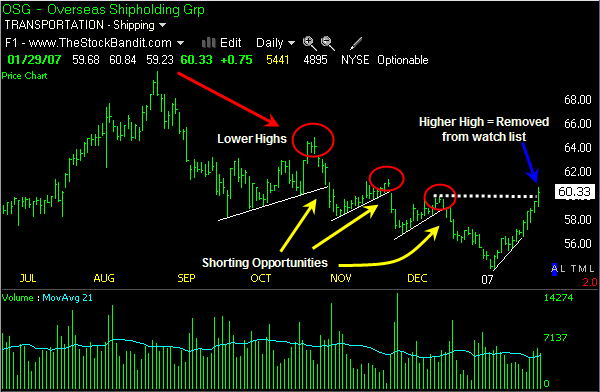 Author Archive for Jeff White
Author Archive for Jeff White
Jeff White is the founder of www.TheStockBandit.com, a nightly newsletter for active traders. He has been trading his own account for over a decade and currently trades full time in Texas.
TeleChart Platinum Sale
March 5, 2007 at 6:13 pm
I just received an email from Worden Brothers regarding a 1-week sale for TeleChart Platinum, their real-time charting program. I’ve been a TeleChart user for 8 years now, and this is the best sale price I’ve seen on their Platinum version (buy 8 months, get 4 free). It works out to $58 per month if you take the 2-year discount (buy 14 months, get 10 free), which is 71% off.
I’ve talked before about why I use this program and why it is the best charting program out there, so if you’re in the market for a charting program to give you a jump on your trading, be sure to check it out. Worden offers a money-back guarantee as well as a 30-day trial, which is impossible to beat.
(Their sale ends March 12th.)
Hope your week is off to a great start!
Jeff White
President, The Stock Bandit, Inc.
www.TheStockBandit.com
[tags]Stock Market, Day Trading, Stock Trading, Investing, Swing Trading, Stock Charts, TeleChart[/tags]
When Bulls Become Sellers
March 1, 2007 at 10:05 am
Tuesday’s big decline did more than just damage the technicals of the market. Not only were uptrends broken and bases in individual stocks completely negated with the high-volume drop, but there was a major shift in the psychology of the bulls.
For more than 7 months now, every single dip has been a good buying opportunity in the market. Lower prices have meant that stocks are on sale, and anyone who forked over some cash to scoop up the bargains was rewarded time after time. This kind of consistent behavior goes a long way toward conditioning traders and investors to buy the dips, and as a result, any pullbacks we have seen during this time have been very shallow.
Then came Tuesday.
Fear was in the air as the day began, and it never did go away. Prices went down like a lead balloon, breaking key technical levels along the way. Whether you watch pivot levels, trend lines, or moving averages, they were each severed with ease for one reason: emotion.
Wide-ranging bars in technical analysis are days which have unusually large trading ranges compared to recent history. Tuesday certainly produced a great number of these on the daily charts, and that is no coincidence. The reason why is that once traders start to see that technical levels aren’t providing adequate support, they get spooked. Emotions run higher and rules are thrown out the window. Support zones are forgotten, and all that starts to matter to those who are holding positions on the long side is getting out. At all cost. As soon as possible.
Bulls who had recently allocated cash to the market and had been sitting on gains all of a sudden in one day found their positions underwater. Green P&L statements provide comfort and confidence, but red P&L statements tend to elevate the blood pressure and raise valid concerns. Add that to the realization that big ugly down days are still possible, and all of a sudden the bulls have ample reason to want to move to the sidelines.
Those same bulls are now much more likely to become sellers into bounces. Will they sell at the first sign of higher prices? Yes, some will. Will some of them try to endure this pullback but eventually capitulate and flee for the safety of cash? Of course.
The point I want to make here is that the motivation of these bulls has changed. Whereas just recently they were concerned that the market might fly to the moon without them, now they realize that the music has at least temporarily stopped and they need a chair to sit in. The fear they have after Tuesday’s big decline is probably going to linger in their minds, and that won’t go away until they make it to the sidelines safely or things start to shape up.
Jeff White
President, The Stock Bandit, Inc.
www.TheStockBandit.com
[tags]Stock Market, Day Trading, Stock Trading, Investing, Swing Trading[/tags]
Tuesday’s Selloff: Cause or Effect?
February 28, 2007 at 5:50 pm
This column was originally published today at 12:20pm EST on the Bandit Bulletin, my intraday trading diary over at TheStockBandit.com. It’s being republished here as a bonus for TheStockBandit.net readers. For more information on subscribing to TheStockBandit.com, please check out our stock pick service.
Tuesday’s selloff was huge to say the least, as the major indexes posted their worst one-day performance since 2001. Days like that don’t go unnoticed (and shouldn’t), so let’s take a little closer look at why it happened.
Monday night’s news flow was negative, there is no doubt about it. A combination of events including China’s stock market, Iran’s defiance on shutting down their nuclear program, and even an attempt on our Vice President’s life in Afghanistan all set the stage for a downside open on Tuesday morning in the US markets.
But was the poor news flow really the cause of such a big correction, or was it merely a spark that ignited something that had been building up for months?
I am no perma-bear or perma-bull, and that should be perfectly clear here, but the truth is that this market has not corrected since last summer, and corrections are a normal part of how the stock market functions. For nearly 7 months, the major indexes have moved steadily higher, with the only “corrective” phases being some sideways price action that worked off overbought conditions. Sideways price action is merely the digestion of gains, but it only involves very limited profit-taking (otherwise, a selloff would occur).
A correction was needed, and the storm clouds had been building in recent weeks. I am not saying that I saw such a big slide coming, because I didn’t. What I am saying is that the character of the market in recent weeks has shown some obvious reluctance to move higher, and that has been noted in the Bandit Broadcast newsletter, on the Market Conditions page, and of course on the Bandit Bulletin trading blog. The technical conditions have favored the bulls with the high bases that had formed, and yet the bulls couldn’t run things up and exploit their edge. Instead, several failed breakouts were the result, which has necessitated caution with longs in recent weeks. Lately I have raised stops rather aggressively, and have also limited the number of positions held because of the lack of upside traction. The combination of failed breakouts and very limited momentum was a good signal to at least limit our buys, so I’m pleased to have been cautious in that regard.
I’ve said a lot of times how important it is to gauge the character of market moves. That will always be important, whether watching the overall market or individual stocks. It’s hard to stay 100% objective on the market, especially when holding positions, but trying to stay objective will always benefit us as traders. I just can’t stress that enough. Keep close tabs on key levels, watch the chart patterns carefully, and always always always consider what is motivating buyers and sellers. Momentum is everything in the market, and when one side has everything in their favor to press things and they don’t, it’s probably time to get more cautious and protect capital more than usual.
Jeff White
President, The Stock Bandit, Inc.
www.TheStockBandit.com
[tags]Stock Market, Day Trading, Stock Trading, Investing, Swing Trading[/tags]
Support and Resistance Role Reversals
February 26, 2007 at 11:07 pm
As traders, we all know that things can quickly change, especially in the market. A good level for buying today might be a better level for selling next week – you just never know so you have to pay attention!
This week’s Free Newsletter over at TheStockBandit.com discusses the topic of Support and Resistance Role Reversals, specifically in regards to how stocks can act around key trend lines once broken, along with an interesting look at a trade we just closed out. Some great trades can be caught after support becomes resistance if you know what to watch for, so stop by and check it out if you get a chance.
By the way, you can sign up for the free newsletter on the Free Newsletter page at TheStockBandit.com. An opt-in form is provided at the top of the page which puts you in full control of your email subscription at all times.
Trade well this week!
Jeff White
President, The Stock Bandit, Inc.
www.TheStockBandit.com
[tags]Stock Market, Day Trading, Stock Trading, Investing, Swing Trading[/tags]
Trading With Patience
February 19, 2007 at 7:39 pm
I’m a pretty impatient person, and that doesn’t always serve me well! When it comes to cutting losses, it is great. When it comes to speeding tickets or losing patience with a trade, it is less than ideal!
This week’s Free Newsletter over at TheStockBandit.com discusses the topic of Trading With Patience, so check it out if you get a chance. I am confident you will relate to at least some of it, and I also offer a few suggestions on how to deal with impatience as a trader.
By the way, you can sign up for the free newsletter on the Free Newsletter page at TheStockBandit.com. An opt-in form is provided at the top of the page which puts you in full control of your email subscription at all times.
Trade well this week!
Jeff White
President, The Stock Bandit, Inc.
www.TheStockBandit.com
[tags]Stock Market, Day Trading, Stock Trading, Investing, Swing Trading[/tags]
“Knight” Writer
February 13, 2007 at 7:11 pm
I am humbled and honored to now be a member of Don Worden’s Roundtable of Knights Who Think for Themselves. Tonight when I made my final TeleChart download, I saw that I have been dubbed “Sir Psychological Capital” by Mr. Worden!
As I’ve noted before, Mr. Worden often presents submitted notes from TeleChart Users along a variety of topics, and they always seem to get my wheels turning. A few recent Worden Reports prompted me to send him a few thoughts of my own, and I’m hopeful it will in turn help some other traders. Here is the note I sent to him:
Mr. Worden,
I am a long-time user of TeleChart and feel that your nightly report alone is worth the price. It’s great to have your insights to blend with my own ideas, so thank you for always sharing your hard-won experience of the past several decades.
I also enjoy reading the nightly Worden Report for the submissions of other TeleChart users. While many of them are more detailed than I may prefer to use, some of them are surprisingly simple and therefore easy to put to use. They also add to the user experience and value of your product, so thank you for sharing those as well!
Sir Smalltiger’s submission on January 3rd was an excellent example of how one should implement a trading plan, and I am in full agreement that each of us should have such a plan in place which fits our needs – whatever those may be. He touched on a number of topics which each trading plan should include, and in that regard his submission was very thorough.
I do feel that an added layer to the topic of exits would be of benefit to any trading plan, and that is the concept of managing positions in a scaling fashion to “peel off” profits on the way up.
Why not include in a trading plan a method for reducing risk and paying oneself along the way as a profit builds? When we catch a good move, we often battle our inner demons to either “let it all ride” or “swipe the winner off the table,” neither of which are ideal. This all-in-or-all-out approach rarely results in satisfaction! Inevitably, the trades which we press will pull back and cause regret, as does the alternative of jumping ship too early, only to see the stock continue higher without us. It’s the ever-present conundrum we face as traders.
I have found that my own solution to this ongoing battle is to book partial profits along the way. I prefer to pay myself when I catch a good move, but retain some portion of my position in order to participate in continued upside should the momentum carry forward. I then raise my stop for remaining shares to reduce risk while maintaining some exposure.
This accomplishes two goals, the first is financial and the second is mostly psychological:
First, I free up more trading capital to allocate toward a new idea. I am a trader, and that means I like to keep the money funneling into areas with the best (perceived) potential.
Second, I sleep easier because I don’t have as much (psychologically) riding on the big winning trade – I’ve paid myself and now have a win/win scenario – barring a gap – in that my raised stop will result in a net gain or that my trade will continue higher and add to my previously booked profits. This also addresses the preservation of “psychological capital” which I believe we each have a limited amount of.
The current market has been good for this approach as numerous times strength has been sold as prices migrate back toward trading ranges. Booking some gains into such advances has provided me with some good profits as well as opportunities to reload my favorite positions on pullbacks.
Every trader should have a plan that suits their own needs, and Sir Smalltiger’s plan is an excellent foundation from which to build. It can be adapted as conditions or situations change, but having some profit-taking method in place is better than the all-or-nothing approach which so many traders employ with limited success.
Thank you again for such an excellent product,
Jeff
Obviously money management is crucial to the success of any trader, but as I write here so frequently, a trader must also protect his psychological capital. Keep that in mind when formulating your trading plan, and you’ll always be on the right track!
Jeff White
President, The Stock Bandit, Inc.
www.TheStockBandit.com
Watch List Management
February 13, 2007 at 2:34 pm
All traders keep watch lists in one form or another. Maybe you jot yours down on a whiteboard in your office or keep some scratch paper close by to write down the symbols you’re keeping an eye on. You might store your watch lists inside your trading platform or charting program. Regardless of where you store it, it’s a fact of life that even watch lists need a little spring cleaning.
My personal preference is to store and manage my watch lists in my charting program TeleChart. (I’ll cover the reasons why in another post, but for now I’ll stick with the subject of managing my watch lists). On a regular basis, I do find that I need to remove certain stocks which no longer fit my trading criteria (for price, volume, volatility, etc.), or which are no longer anywhere close to areas from which I would initiate new entries. I want to keep the list clean and organized and of the highest quality possible, as that will let me quickly find trading opportunities when the conditions are right.
Timing is Everything
Every one of us is busy, so it can be hard to set aside some time to streamline our charting process. I’ve found that when the market stagnates, it’s the perfect time for managing my watch lists. Whether it’s an intraday lull in the action or it’s just shaping up to be a slow week (like Bernanke scheduled to speak the next day), these resting phases in the market action tend to free up my attention from trading. It’s on these days that I devote some time to removing the dogs from my lists so that I can refine and rebuild my watch list. I make sure to also remove any clutter which no longer belongs on the list (stocks which now have significant gaps, have reversed suddenly, or simply are no longer poised for the initiation of a new swing trade).
Here’s an example of a stock I recently removed from my watch list. OSG had provided some great shorting opportunities in recent months (note the lower highs), but once it cleared the previous high recently, the downtrend was broken so I took it off my watch list.
Making Space for New Ideas
By paring back my list to only those stocks which meet my criteria, I also create space for adding new names to the list. Freeing up some room for new watch list candidates lets me get to one of my favorite activities in the market: scanning and sorting. I love to dig up new trading ideas and locate the stocks which were previously flying under the radar, but I’m less inclined to do this if my watch lists are already too large to use effectively.
Managing my watch lists also includes redrawing trend lines, updating new support and resistance levels, and of course locating new chart patterns. This also contributes to the flow of new ideas as refined entry and exit levels become apparent. My watch lists are truly the lifeblood of my trading!
So the next time the market slows down and enters a resting phase, remember it isn’t worth trading. Instead, use that time to build and edit your shopping list so that once things do start moving again, you’ll be that much closer to having your game plan in place. Put on some good music, kick back and work those watch lists!
Jeff White
President, The Stock Bandit, Inc.
www.TheStockBandit.com
[tags]Investing, Swing Trading, Day Trading, Stock Watch Lists, TeleChart[/tags]







